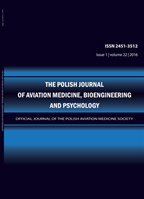2023, Volume 29, Issue 1
REVIEW OF LOWER BODY NEGATIVE PRESSURE APPLICATIONS TO SIMULATE +GZ-INDUCED CARDIOVASCULAR STRAIN: RESEARCH HISTORY
RAFAŁ LEWKOWICZ1, MARIUSZ KREJ2, PAULINA BARAN2, MIROSŁAW DEREŃ2, ŁUKASZ DZIUDA2
-------------------------------------------------------------------------------------------------
1Simulator Study and Aeromedical Training Division, Military Institute of Aviation Medicine
2Department of Psychophysiological Measurements and Human Factor Research, Military Institute of Aviation Medicine
Autor korenspondencyjny: RAFAŁ LEWKOWICZ; Simulator Study and Aeromedical Training Division, Military Institute of Aviation Medicine; email: rlewkowicz@wiml.waw.pl
Full text
Streszczenie
Introduction: In the paper, a general overview of the development and applications of l ower body negative pressure ( LBNP) technology have been provided. The article also descr ibes the LBNP designs used to investigate the relationship between tolerance to negative pressure around the lower body and tolerance to acceleration (+Gz).
Methods: A systematic review of the literature on the development and application of LBNP in the sc ope not limited to the time or geography framework was explored. Searches were performed using predefined keywords and filters for LBNP (e.g., aerospace, medicine, cardiovascular, space, acceleration, Gz ). Databases such as PubMed, IEEE Xplore, ScienceDire ct, and others relevant to this field of study were selected for the search.
Results: The results of the review were organized by thematic categories (LBNP development, applications and use to s imulate +Gz induced cardiovascular strain ). Syntheses of the r esults are presented, highlighting key themes and insights.
Discussion and Conclusion: T he use of LBNP to simulate cardiovascular strain, typically induced by positive G forces (+Gz) in fighter jet flight, has played an important role in our understanding of the cardiovascular response to gravitational forces. This knowledge not only benefits pilots, but also has wider implications for healthcare and working conditions where individuals may face similar physiological challenges. Although numerous reports su pport the development of LBNP for space mission applications, there is no evidence for the use of LBNP to simulate accelerations greater than +1 Gz over the past two decades. However, further research in this area is still warranted.
Słowa kluczowe
aviation me dicine, LBNP, negative pressure, acceleration stress
